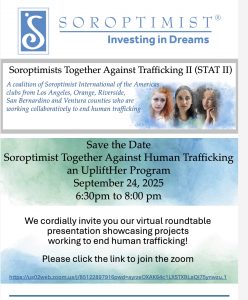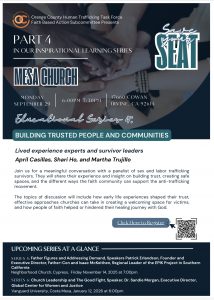Soroptimists Together Against Trafficking II (STAT II) is a coalition of Soroptimist International of the Americas clubs from Los Angeles, Orange, Riverside, San Bernardino and Ventura counties who are working collaboratively to end human trafficking

Fight Fast Fashion and Labor Trafficking on Oct 16th!
Join the Live2Free Club, Global Center for Women and Justice, at Vanguard University for an informative and fun evening


Reserve Your Seat for Part 4 at Mesa Church on Sept 29th
Building Trusted People and Communities Survivor Panel Part 4 of the OCHTTF’s Faith Based Action Subcommittee’s The Call for Compassion: Human

Jury Award in Georgia: $40 Million in sex trafficking case
In July, a federal jury in the U.S. District Court for the Northern District of Georgia sent a powerful and
